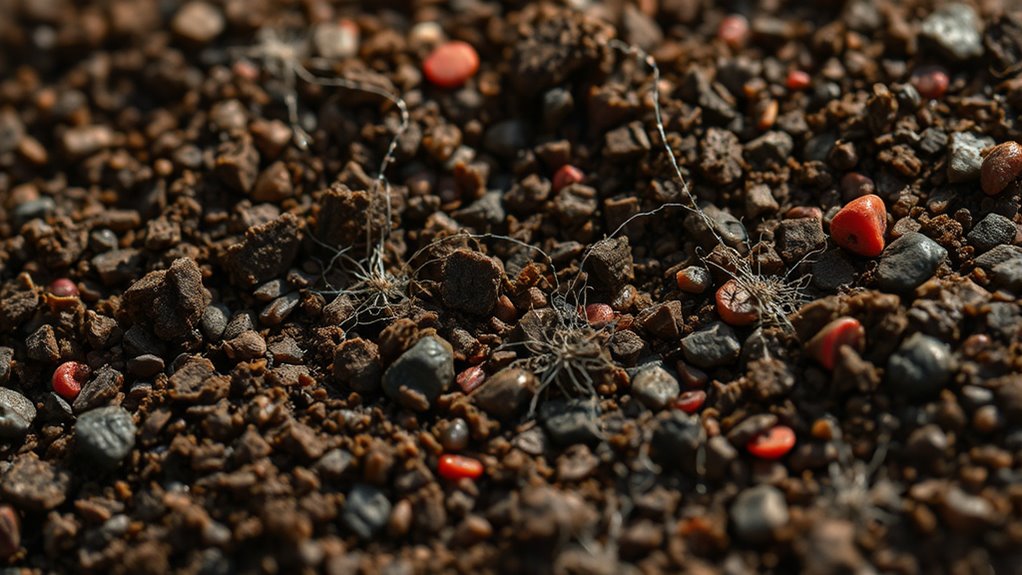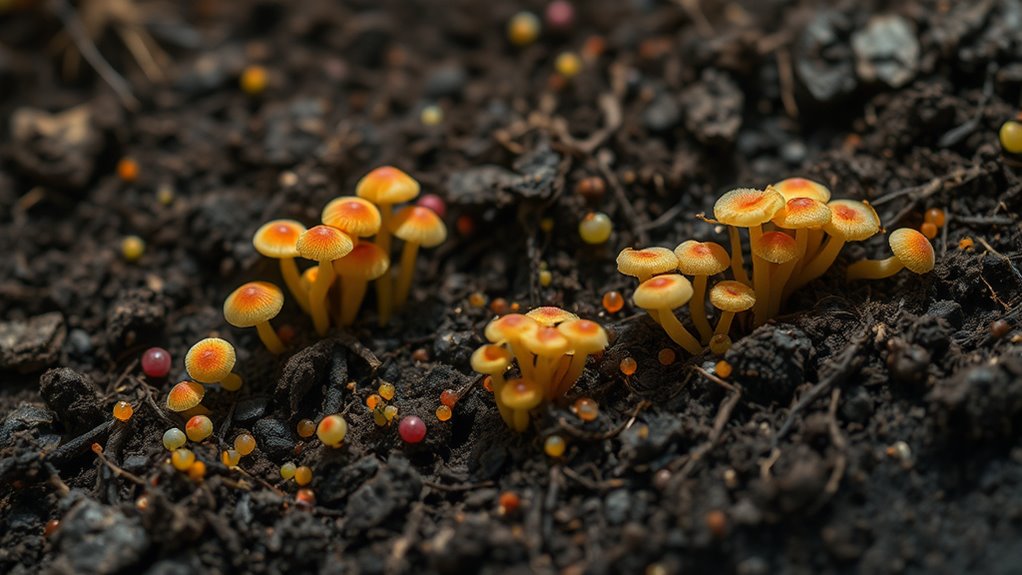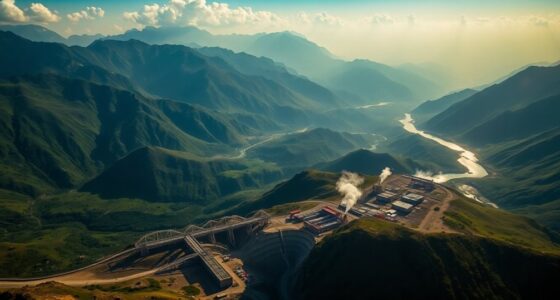Soil microbiomes are an invisible network of tiny organisms that keep us alive by supporting plant growth, recycling nutrients, and maintaining ecosystem health. They break down organic matter and promote healthy soil, essential for agriculture and natural habitats. Pollution damages these microbial communities, leading to reduced soil fertility and environmental imbalances. Protecting this hidden world is critical for sustainability. Keep exploring to discover how these microorganisms influence our everyday lives and the planet’s future.
Key Takeaways
- Soil microbiomes consist of diverse microorganisms vital for nutrient cycling, plant growth, and maintaining soil health.
- Pollution disrupts microbial communities, reducing beneficial microbes and weakening ecosystem resilience.
- Microbial activity drives organic matter decomposition, essential for soil fertility and sustainable agriculture.
- Imbalances in soil microbes due to pollution lead to decreased crop yields and environmental degradation.
- Sustainable practices and pollution reduction are crucial for preserving the vital microbial networks beneath our feet.

Have you ever wondered what tiny organisms live beneath your feet and how they influence the world around us? Beneath the soil’s surface exists a bustling, invisible universe filled with countless microorganisms. This domain, known as the soil microbiome, is incredibly diverse, with countless bacteria, fungi, viruses, and protozoa working together in complex networks. Your understanding of soil microbial diversity reveals that these tiny life forms are essential for maintaining healthy ecosystems. They help decompose organic matter, recycle nutrients, and foster plant growth. Without them, the plants that sustain life on Earth would struggle to thrive, and the entire food chain would be affected.
Beneath our feet, diverse microorganisms drive ecosystem health and plant growth.
However, this delicate balance is increasingly threatened by human activities. One of the biggest threats comes from pollution, which disrupts the soil microbiome’s natural functions. When pollutants such as pesticides, heavy metals, or industrial waste seep into the soil, they can harm or kill beneficial microorganisms. This impacts not just the microbial diversity but also the entire ecosystem’s health. The impact of pollution extends beyond just killing microorganisms; it can cause a shift in the microbial community structure, favoring species that are more resistant but less beneficial to soil health. This imbalance reduces the soil’s ability to support plant life, leading to poorer crop yields and degraded natural habitats.
The impact of pollution on soil microbes is profound because these tiny organisms are the foundation of soil fertility. They facilitate nutrient cycling, breaking down organic matter into forms that plants can absorb. When pollution hampers their activity, nutrient cycling slows down, causing plants to struggle and making soils less productive. This, in turn, affects agriculture and natural ecosystems, compounding environmental problems like erosion and desertification. It’s a cycle where pollution diminishes microbial diversity, which weakens the soil’s resilience and hampers its ability to recover naturally.
Understanding the importance of soil microbial diversity and recognizing the impact of pollution highlights the need for sustainable practices. By reducing pollutants and adopting eco-friendly farming and land management, you can help preserve this hidden world beneath your feet. Protecting soil microbes isn’t just about safeguarding the environment; it’s about ensuring the health of every living thing that depends on the soil’s vitality. The tiny organisms beneath your feet hold the key to a sustainable future, and it’s up to us to keep their world intact.
Frequently Asked Questions
How Do Soil Microbiomes Affect Plant Disease Resistance?
Soil microbiomes play a vital role in enhancing your plant’s disease resistance. They boost the plant immune system by fostering microbial diversity, which helps suppress harmful pathogens. When healthy soil microbiomes thrive, they create a protective barrier around your plants, making it harder for diseases to take hold. You can support this by maintaining diverse, organic soils, ensuring your plants stay resilient against various diseases.
Can Soil Microbiomes Be Altered to Improve Crop Yields?
Think of soil as a bustling marketplace; its microbial diversity is the vibrant crowd that influences crop productivity. You can alter soil microbiomes by adding beneficial microbes, practicing crop rotation, or using organic amendments. These changes boost microbial diversity, which in turn enhances nutrient availability and plant health. By actively managing these factors, you can improve crop yields and create a resilient, thriving agricultural ecosystem.
What Are the Main Factors Disrupting Soil Microbial Communities?
You should know that soil microbial communities are disrupted mainly by pesticide impact and tillage practices. Pesticides can kill beneficial microbes, reducing soil health, while intensive tillage disturbs the soil structure, harming microbial habitats. These practices lower microbial diversity and activity, which can hurt plant growth. To protect soil health, consider reducing pesticide use and adopting conservation tillage methods, helping your soil microbiomes thrive and support better crop yields.
How Do Soil Microbiomes Influence Greenhouse Gas Emissions?
Imagine a farm where healthy soil microbiomes actively convert greenhouse gases into beneficial compounds. Your soil’s microbial communities influence greenhouse gas emissions by regulating processes like nitrogen fixation and decomposition. They help with carbon sequestration, trapping carbon in the soil and reducing overall greenhouse gases. When these microbes thrive, emissions decrease; when disrupted, they release more gases, impacting climate change. Your actions can support healthy soil microbiomes for a sustainable future.
Are Soil Microbiomes Different Across Various Ecosystems Worldwide?
You’ll find that soil microbiomes differ across ecosystems worldwide due to variations in soil diversity and environmental conditions. These differences lead to microbial variation, which influences nutrient cycling and ecosystem functions. Forests, deserts, wetlands, and agricultural lands each host unique microbial communities. By understanding this diversity, you can better appreciate how soil microbiomes adapt to their environments, supporting plant growth and maintaining ecological balance globally.
Conclusion
You walk through a vibrant world beneath your feet, unseen yet essential. While you tend to plants and harvest crops, tiny soil microbes tirelessly work behind the scenes, sustaining life in ways you can’t see. Their complex ecosystem, often hidden, is the silent force that keeps you alive—more than just dirt; it’s the foundation of life itself. In this hidden world, your survival and the Earth’s future are deeply intertwined.










